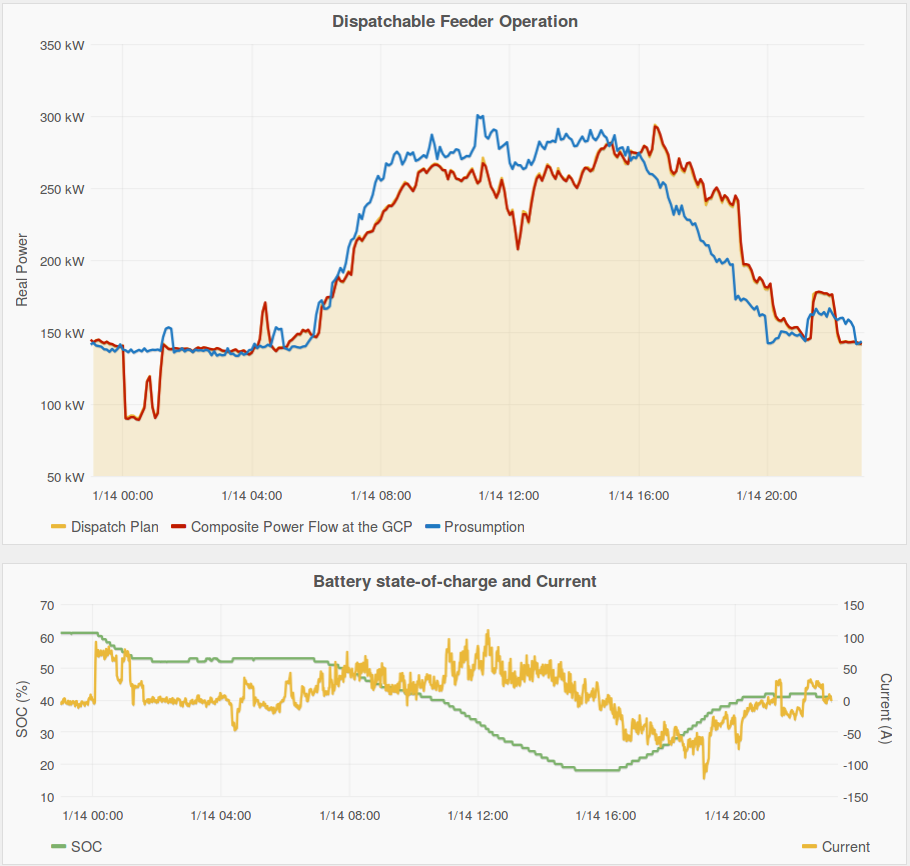A compelling problem associated to integrating larger shares of production from renewables is the increased amount or regulating power required to operate the grid. We tackle this challenge by proposing to dispatch the operation of portion of distribution systems according to a profile that is established the day before operation. In other words, we make sure that a given cluster of prosumers follows a predetermined prosumption (namely, demand plus distributed generation) profile thanks to properly controlling the power injection of a battery energy storage system (BESS).

This idea is validated in the so-called EPFL dispatchable feeder experimental setup, which is shown in the Figure below and consists in 5 office buildings (peak consumption 300~kW) equipped with a significant amount of PV generation (95~kWp) and an utility-scale 720~kVA/500~kWh BESS.
The strategy consists in a two-stage procedure: day-ahead and real-time operation.
The day before operation, the prosumption profile that the cluster of prosumers should follow during operation (called dispatch plan) is determined thanks to forecasting the demand and the global horizontal irradiance (GHI). The dispatch plan also incorporate the amount of energy that is necessary to restore an appropriate BESS state-of-charge (SOC), in order to make sure that enough residual energy is available the day after to track the dispatch plan during operation.
In real-time, the BESS real power injection is controlled in order that the power flow at the GCP follows the dispatch plan. This is accomplished by applying model predictive control.
An example of dispatchable feeder operation is shown in the Figure below (experimental measurements from January, 14th 2016). The plot in the top panel shows the dispatchable plan in yellow, the prosumption realization in blue, and the power flow observed at the grid connection point (GCP): it is visible that the power flow at the GPC sticks to the dispatch plan, therefore achieving to dispatch the prosumption. The plot in the bottom panel, shows the SOC (which oscillates in the 20-60 percent region) and the current profile of the battery.

The topics under investigation are procedures to determine the BESS size and stacking of ancillary services, namely how it is possible to provide different power system ancillary services by using the same BESS.
Publications
F. Sossan, E. Namor, R. Cherkaoui and M. Paolone, “Achieving the Dispatchability of Distribution Feeders Through Prosumers Data Driven Forecasting and Model Predictive Control of Electrochemical Storage,” in IEEE Transactions on Sustainable Energy, vol. 7, no. 4, pp. 1762-1777, Oct. 2016.
E. Namor, F. Sossan, R. Cherkaoui and M. Paolone, “Load leveling and dispatchability of a medium voltage active feeder through battery energy storage systems: Formulation of the control problem and experimental validation,” 2016 IEEE PES Innovative Smart Grid Technologies Conference Europe (ISGT-Europe), Ljubljana, 2016, pp. 1-6.
E. Namor, D. Torregrossa, F. Sossan, R. Cherkaoui and M. Paolone, “Assessment of battery ageing and implementation of an ageing aware control strategy for a load leveling application of a lithium titanate battery energy storage system,” 2016 IEEE 17th Workshop on Control and Modeling for Power Electronics (COMPEL), Trondheim, 2016, pp. 1-6.
E. Stai, L. Reyes, F. Sossan, J-Y. Le Boudec, M. Paolone, “Dispatching Stochastic Heterogeneous Resources Accounting for Grid and Battery Losses”, Submitted to Transactions on Smart Grid, 2017. Available on https://infoscience.epfl.ch